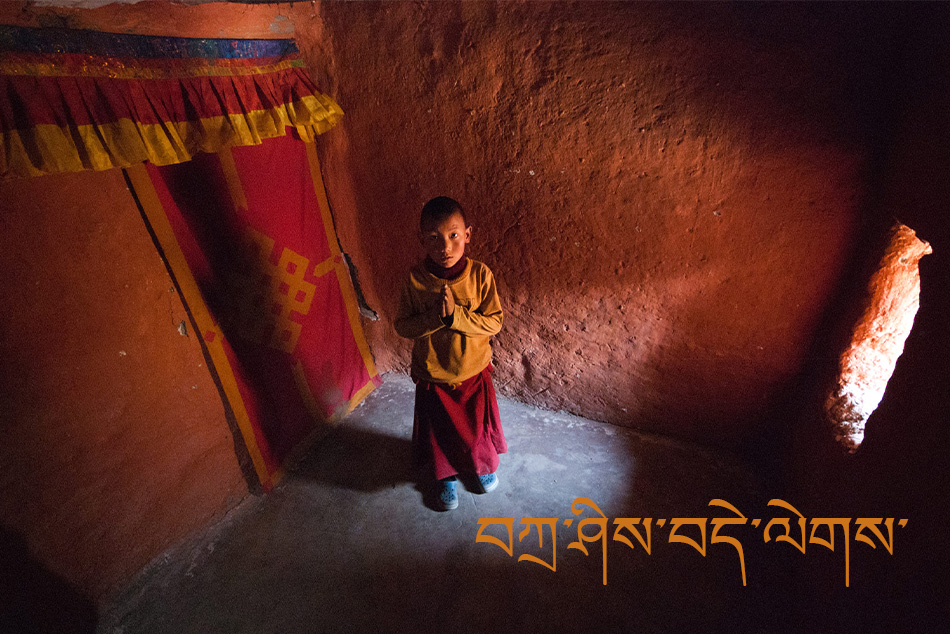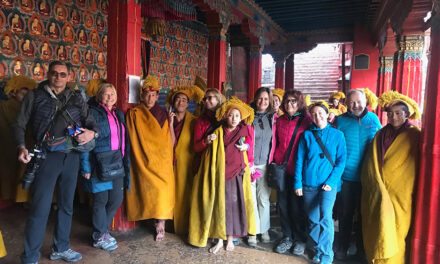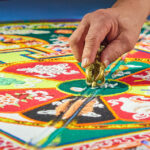Tashi Delek བཀྲ་ཤིས་བདེ་ལེགས་ In the diversity of world cultures, greetings serve as the first brushstroke on the canvas of human interactions. They are a universal language that transcends linguistic boundaries, providing a glimpse into the values, beliefs, and aspirations that define a community. Much like the vibrant threads of a tapestry, greetings weave together the fabric of human connection, offering insight into the collective soul of a people.
In this intricate mosaic of greetings, “Tashi Delek བཀྲ་ཤིས་བདེ་ལེགས་” stands out as a gem from the highlands of Tibet. It is not just a customary salutation but a profound expression of benevolence that resonates deeply with the Tibetan ethos. The words themselves, “Tashi Delek,” create a bridge between individuals, connecting hearts and minds in a shared moment of goodwill.
As we delve into the essence of “Tashi Delek” in this article, we will uncover the layers of its rich meaning. We will explore how this greeting is not merely a set of sounds but a reflection of a culture that values auspiciousness, unity, and the well-being of all. Understanding “Tashi Delek” allows us to step into the world of Tibet, where tradition and modernity coexist, and where respect and warmth flow freely in human interactions.
Throughout this journey, we will navigate the cultural context that gave birth to “Tashi Delek” and its evolution into a year-round greeting, embracing both strangers and loved ones. We will learn how it serves as an embodiment of the Tibetan spirit, one that radiates warmth and harmony.
In the pages that follow, we will not only decipher the linguistic components of “Tashi Delek” but also delve into its significance as a unifying force in Tibetan society. It acts as a conduit of goodwill, breaking down barriers and fostering a sense of camaraderie among individuals from diverse backgrounds.
Furthermore, we will examine the proper etiquette of responding to “Tashi Delek,” as respect and reciprocity are at its core. Whether you are a traveler in Tibet or engaging with Tibetans elsewhere, understanding the nuances of this greeting can open doors to genuine connections.
As we explore the cultural landscape of Tibet and its interactions with neighboring regions, we will witness the global reach of “Tashi Delek.” It transcends borders, touching the hearts of those who appreciate its deeper meaning and universal message of hope and well-being.
What is Tashi Delek?
In the vast ocean of global greetings, “Tashi Delek” stands as a jewel from the heart of Tibet. The phrase, pronounced as “Tah-shee Day-lek,” is a harmonious blend of two Tibetan words: “Tashi” and “Delek.” The word “Tashi” embodies the essence of “auspiciousness” and “good fortune,” painting a picture of a world brimming with positivity and hope. Meanwhile, “Delek” is a word that carries the gentle promise of “to come” or “to be with,” offering a warm invitation to unity and togetherness. In the fusion of these two words, “Tashi Delek” becomes a heartfelt expression, akin to saying, “May auspicious blessings accompany you on your journey” or “May all good things find their way to you.”
Significance of Tashi Delek in Tibetan Culture
Tibetan culture, with its rich tapestry of traditions and spiritual depth, has always held “Tashi Delek” close to its heart. While this greeting has gracefully transcended its original purpose, traditionally, “Tashi Delek” was closely associated with the Tibetan New Year, Losar. This special time of the year served as the backdrop for the exchange of these auspicious blessings. However, over the years, the warm-hearted people of Tibet have extended the reach of “Tashi Delek.” It has become a universal greeting, encompassing not just the familiar faces of friends and family but also welcoming strangers into the fold.
At its core, “Tashi Delek” reflects the genuine warmth and hospitality of Tibetan culture. It’s a greeting that encapsulates the essence of the Tibetan people – a culture that values goodwill and harmony above all. This cultural significance is deeply ingrained, and its echoes can be felt year-round, from bustling cities to remote mountain villages. In every instance, “Tashi Delek” is a testament to the enduring spirit of this unique culture, offering open arms and kind wishes to those who cross its path.
The Meaning Behind Tashi Delek
To fully grasp the profound meaning of “Tashi Delek,” we must explore its intricate linguistic components. Each syllable weaves a unique strand into the tapestry of this heartfelt Tibetan greeting.
“Tashi” encompasses a world of positive connotations. It signifies not just good but the essence of goodness itself. It’s a beacon of light, a symbol of brightness that guides one’s path. When you utter “Tashi,” you evoke the image of a perfect day, a future filled with auspiciousness. It’s an aspiration for the best, a wish for the sun to shine on your life.
“Shi” enters the conversation, bearing the promise of good results. It’s the echo of harmony and the whisper of dreams fulfilled. When “Shi” finds its place in “Tashi Delek,” it ensures that not only will your journey be filled with good fortune, but it will lead you to the harmonious shores of success.
“De” adds another layer to this profound greeting. It is the embodiment of serenity, a call for freedom from the burdens of disease, disaster, and conflict. It is a plea for the world to be at peace, for happiness to prevail, and for joy to reign supreme. “De” carries with it the tranquility of a quiet stream, the warmth of a peaceful home, and the joy of a heart in harmony.
“Lek” crowns the phrase, radiating beauty, goodwill, and wish fulfillment. It represents the cleanliness of a pure heart and the beauty of a soul untainted by malice. When “Lek” enters the conversation, it bestows an abundance of benefits and a sense of fulfillment, as if your deepest desires have been answered.
Traditional Usage and Modern Adaptation
While “Tashi Delek” has deep roots in the traditions of the Tibetan New Year, it has gracefully adapted to modern times. Originally, it was a sacred chant, a part of a larger invocation during Losar, embodying the spirit of the occasion. However, with the shifting sands of time and the dispersion of Tibetan communities across the world, “Tashi Delek” has transcended its traditional boundaries.
Today, it is not confined to the auspicious New Year alone. “Tashi Delek” has evolved into a year-round greeting, extending a warm hand to both strangers and loved ones. It has become a universal key that opens doors to conversations and connections. In this way, “Tashi Delek” serves as a bridge between tradition and modernity, maintaining its deep cultural roots while embracing the diversity of the global community.
This greeting, now more accessible than ever, serves as a heartwarming icebreaker, creating an atmosphere of friendliness on the vast expanse of the Tibetan Plateau and far beyond. In its modern adaptation, “Tashi Delek” has blossomed into a beacon of goodwill, a reminder of the enduring values of the Tibetan people, and a testament to their warm and hospitable nature.
When and Where to Use Tashi Delek
Warmth and Hospitality
Tashi Delek is more than a mere greeting; it is a gateway to the heart of Tibetan hospitality. In a land where warmth and respect are paramount, this phrase stands as a symbol of goodwill and a genuine desire for harmony. It holds the power to create a friendly atmosphere in an instant, whether you are extending it to a stranger or welcoming a guest into your home.
Imagine stepping into a Tibetan household for the first time. As you cross the threshold, you are greeted with the soothing words of “Tashi Delek.” It’s an immediate invitation to feel at ease, a sign that you are a welcome guest in this space. The barriers of unfamiliarity begin to crumble, and a sense of camaraderie emerges. In these moments, “Tashi Delek” is not just a phrase; it is an embodiment of the age-old Tibetan tradition of hospitality.
As you initiate a conversation with a Tibetan, you’ll find that a simple “Tashi Delek” can work wonders. It’s not just a salutation; it’s an unspoken invitation to connect, a way to reach out to others with an open heart. In response, the warmth in the eyes of the Tibetan you’ve greeted will be palpable. It’s as if you’ve opened a door to their inner world, and they welcome you in with a smile that transcends language.
Festivals and Celebrations
Tashi Delek finds its most potent expression during festivals and special occasions in Tibet. These moments of jubilation and reverence are marked by the exchange of this sacred blessing among friends, family, and members of the community. It’s a beautiful tradition that goes beyond mere words; it signifies unity, harmony, and shared happiness.
Imagine the exuberance of Losar, the Tibetan New Year. It’s a time when the entire community comes together to celebrate a fresh beginning. Amidst the festivities, “Tashi Delek” becomes the most precious gift one can offer. It encapsulates the spirit of the occasion, encapsulating the hopes and dreams of the community for a year filled with auspiciousness and joy.
During these celebrations, it’s not uncommon to witness the exchange of traditional Tibetan white scarves, known as “khata.” These scarves, often offered along with “Tashi Delek,” symbolize deep respect and good wishes. They serve as tangible expressions of the warm sentiments carried by this greeting, weaving a tapestry of unity and goodwill among all those who partake in the festivities.
In essence, “Tashi Delek” is the golden thread that weaves through the fabric of Tibetan culture during moments of joy and celebration, reinforcing the bonds of love, friendship, and shared happiness.
How to Respond to Tashi Delek
When you travel to Tibet, you’ll quickly encounter the warm embrace of “Tashi Delek.” It’s a greeting that extends beyond language, a bridge that connects you with the hearts of the Tibetan people. But the beauty of “Tashi Delek” is not just in saying it; it’s also in how you respond.
In the enchanting land of Tibet, when someone bestows the blessing of “Tashi Delek” upon you, it carries more than the weight of a simple salutation. It’s akin to extending a hand of friendship, an offering of goodwill and respect. In this moment, you have the opportunity to reciprocate and join the beautiful dance of mutual warmth.
“Tashi Delek” can be likened to “hello” or “welcome” in the context of Tibetan culture. As you hear these heartfelt words, it’s your turn to respond with equal warmth. A polite and gracious reply is to echo “Tashi Delek” in the same manner. In doing so, you not only acknowledge the sentiment behind the greeting but also embrace the connection that’s being offered to you.
For a more native touch, you can take it a step further. As you respond with “Tashi Delek,” consider placing your hands together in a gesture of respect. This act is not just a formality; it’s a symbol of the reverence you hold for the person who has extended their good wishes to you. It’s a subtle yet profound way of saying, “I appreciate your kindness, and I reciprocate with the same level of respect and warm wishes.”
In the act of responding to “Tashi Delek,” you become a part of the beautiful tapestry of Tibetan culture. It’s a moment of connection, a bridge between two worlds, and a reminder that, in the end, we are all bound by the threads of humanity and goodwill. So, when you hear “Tashi Delek” in Tibet, know that it’s an invitation to join a dance of respect and friendship, and your response is the first step in that harmonious journey.
Tashi Delek Beyond Tibet
The beauty of profound greetings is that they have the potential to transcend borders and cultures. In the case of “Tashi Delek,” its reach extends far beyond the rugged terrain of Tibet. It carries with it the powerful echoes of Tibetan culture, a culture deeply rooted in Buddhism and the values of goodwill and unity.
In regions influenced by Tibetan Buddhism, such as Bhutan and Nepal, the resonant sound of “Tashi Delek” can be frequently heard. Here, it is not just a greeting; it’s a way of life. The ethos of harmony and auspiciousness that “Tashi Delek” embodies finds resonance among those who share these spiritual and cultural connections.
Bhutan, often referred to as the “Land of the Thunder Dragon,” is one such place where “Tashi Delek” has found a home. As a nation deeply influenced by Tibetan Buddhism, it embraces the greeting in the same spirit as Tibet itself. “Tashi Delek” becomes a thread that binds people together, fostering an atmosphere of mutual respect and goodwill.
Nepal, with its unique blend of cultures, is another region where the echoes of “Tashi Delek” can be heard. Here, it serves as a reminder of the interconnectedness of cultures and the power of a simple greeting to bridge gaps and build connections.
As Tibetan culture has interacted with the global community, “Tashi Delek” has transcended cultural boundaries. It has gained recognition and appreciation worldwide, not just as a phrase but as a symbol of the values it represents. The universal message of goodwill, unity, and the aspiration for all things auspicious has resonated with people from diverse backgrounds.
So, when you hear the gentle resonance of “Tashi Delek” beyond the borders of Tibet, know that it’s a reminder of the shared human desire for peace, harmony, and well-being. It’s a testament to the power of greetings to unite hearts and transcend cultural differences, making the world a little smaller and a lot more connected.
Final Thoughts
In the heart of Tibet, a greeting echoes through the ages – “Tashi Delek.” It is more than just words; it is a beacon of goodwill and a symbol of the Tibetan spirit. As we conclude this journey through the meaning, cultural context, and usage of “Tashi Delek,” let us reflect on the enduring significance of this greeting.
“Tashi Delek” is a universal blessing in Tibet, transcending the boundaries of time and place. It is a versatile salutation suitable for almost all occasions. It carries within it the collective hopes for good luck, prosperity, well-being, and lasting happiness. Whether you are conversing with friends, family, or strangers, the utterance of “Tashi Delek” has the magical ability to create a warm and intimate atmosphere, fostering connections that go beyond language.
When you meet or communicate with Tibetans, “Tashi Delek” is not just a string of syllables. It embodies the very essence of Tibetan culture, a culture that values auspiciousness, harmony, and goodwill for all. It is a universal gesture that speaks to the hearts of those who hear it, a reminder that, regardless of our differences, we all share common desires for a brighter, more harmonious world.
So, whether you are planning a journey to the breathtaking landscapes of Tibet or simply seeking to embrace the warmth of this beautiful greeting, know that “Tashi Delek” is more than just a phrase; it is a key that opens the door to a world of culture, tradition, and heartfelt connections. It signifies not just a greeting but a profound desire for the well-being of all. Understanding the meaning and usage of “Tashi Delek” is an essential step in immersing yourself in the rich and vibrant tapestry of Tibetan culture.
For those intrigued by the allure of “Tashi Delek,” consider venturing to Tibet and becoming a part of the culture that has nurtured this beautiful tradition. In the land of towering mountains, serene monasteries, and welcoming smiles, you can experience firsthand the power of a simple greeting to bridge cultures and create lasting connections.
Conclusion
In the grand tapestry of human greetings, “Tashi Delek” stands as a jewel, radiating far more than mere words. It is not just a greeting; it is a profound expression of goodwill and blessings that carries the hopes and dreams of a community, a culture, and a people.
Through our journey into the heart of “Tashi Delek,” we’ve uncovered the intricate tapestry of its linguistic components and its deep cultural context. It is a greeting that transcends borders, languages, and backgrounds, for it resonates with people worldwide.
“Tashi Delek” is more than just a phrase; it is a heartfelt wish for auspiciousness, harmony, and the fulfillment of all good things. It embodies the desire for well-being, good fortune, and happiness. It is a bridge that connects hearts, a testament to the universal values that bind us all.
As we part ways with this exploration of “Tashi Delek,” let us carry with us the understanding that greetings are not mere formalities but bridges that connect us. They are the threads that weave the fabric of human connections, and “Tashi Delek” is a shining example of this profound truth.
In the end, “Tashi Delek” reminds us that no matter where we come from or where we are headed, the desire for goodness, harmony, and well-being is a universal language that unites us all. So, may the blessings of “Tashi Delek” accompany you on your journey, wherever it may lead.
FAQs on Tashi Delek
What is the Literal Translation of “Tashi Delek”?
The beauty of language lies in its ability to encapsulate the profound in the simplest of words. In the case of “Tashi Delek,” those two words hold within them a universe of meaning. To truly appreciate this Tibetan greeting, we must delve into its literal translation.
“Tashi,” the first part of the greeting, carries the weight of auspiciousness, goodness, brightness, and perfection. It signifies the hope for a future filled with positive outcomes, where everything is in harmony and balance.
“Delek,” the second part, is a wish for the recipient to experience a life free from disease, disaster, conflict, and disorder. It embodies serenity, peace, happiness, and joy. It is a desire for life to be adorned with all things beautiful and great, where wishes are fulfilled, and benefits abound.
When we bring these two parts together, “Tashi Delek” becomes a powerful expression of goodwill and blessings. It translates to “auspicious blessings” or “may all good things come to you.” It is a wish for a life filled with positivity, well-being, and the fulfillment of dreams.
So, when you hear or utter “Tashi Delek,” remember that it is more than a greeting; it is a heartfelt desire for the best of everything to come your way. It is a reminder that language, in all its simplicity, has the power to convey the deepest of sentiments and hopes.
Is “Tashi Delek” Only Used in Tibet?
The resonance of a heartfelt greeting knows no boundaries, and this is especially true for “Tashi Delek.” While it finds its roots in the highlands of Tibet, it has gracefully transcended geographical confines, reaching hearts and ears far beyond the Tibetan plateau.
Tibet: The birthplace of “Tashi Delek” and its most ardent custodian. In Tibet, it is not just a greeting; it’s a way of life, a symbol of the warm and hospitable nature of the Tibetan people.
Bhutan: Often referred to as the “Land of the Thunder Dragon,” Bhutan has embraced “Tashi Delek” as a part of its cultural fabric. In this nation deeply influenced by Tibetan Buddhism, the greeting carries the same significance as it does in Tibet. It symbolizes unity, harmony, and goodwill.
Nepal: With its unique blend of cultures, this region has also adopted “Tashi Delek.” Here, it serves as a reminder of the interconnectedness of cultures and the power of a simple greeting to bridge gaps and build connections.
But the story of “Tashi Delek” doesn’t end here. As Tibetan culture has interacted with the global community, this phrase has transcended cultural boundaries, gaining recognition and appreciation worldwide. It has become a symbol of goodwill and unity, a testament to the power of greetings to connect people, regardless of their backgrounds.
So, while “Tashi Delek” found its beginnings in Tibet, it has blossomed into a universal expression of good wishes and blessings. It is a reminder that, in the diverse tapestry of human cultures, the desire for happiness, harmony, and well-being is a language that knows no borders.
How Should One Respond to “Tashi Delek”?
In the enchanting realm of Tibetan culture, greetings are not just exchanges of words; they are bridges to the heart. When someone extends the warm and sincere greeting of “Tashi Delek” to you, it’s not just a formality—it’s an invitation to connect and share in a moment of goodwill.
So, how should one respond to this heartfelt greeting? The answer is simple and beautiful.
“Tashi Delek.”
Yes, when you hear “Tashi Delek,” you can reciprocate with the very same words. It’s a way of acknowledging the sentiment behind the greeting, a way of saying, “I appreciate your kindness, and I return it with equal warmth.”
But there’s a touch of grace you can add to your response. In the spirit of Tibetan culture, consider accompanying your words with a respectful gesture. Place your hands together as a symbol of respect, acknowledging the goodwill that has been extended to you.
In this act of reciprocity, you become a part of the beautiful tapestry of Tibetan culture. You join the dance of connection, where words and gestures become the threads that weave bonds of respect and friendship. It’s a reminder that, despite our differences, we are all bound by the threads of humanity and goodwill.
So, when you encounter “Tashi Delek” in Tibet, know that it’s an invitation to share in a moment of connection and goodwill. Your response is not just a reply; it’s the first step in a harmonious journey of respect and friendship.
Are There Other Similar Tibetan Greetings?
Certainly, Tibetan culture is rich with expressions of blessings and good wishes, and “Tashi Delek” is just one beautiful example. Within the tapestry of Tibetan greetings, you’ll find a variety of phrases, each carrying its own unique message of hope and goodwill.
- Ku Kham Sang: This phrase, much like “Tashi Delek,” is a heartfelt greeting that conveys warm blessings and good wishes. It’s a way of extending positive energy and auspiciousness to those you meet. “Ku Kham Sang” is a reminder that in Tibetan culture, harmony and well-being are deeply valued.
- Kham Sang: A simpler variation of the above, “Kham Sang” is used to express blessings and goodwill. It’s a way of wishing others happiness and prosperity, creating an atmosphere of positivity and harmony.
- Gong Dang: While not a greeting in the same sense as “Tashi Delek,” “Gong Dang” is a Tibetan expression used to convey apologies or to express sorrow. It’s a way of acknowledging one’s own mistakes or shortcomings. This phrase highlights the importance of humility and the desire for harmonious relationships.
These greetings, much like “Tashi Delek,” are not mere words; they are expressions of the values and beliefs that define Tibetan culture. They serve as reminders that in the world of Tibetan interactions, goodwill and positivity are at the forefront. So, while “Tashi Delek” is a beautiful way to extend blessings and good wishes, it’s just one thread in the intricate tapestry of Tibetan expressions of kindness and harmony.














